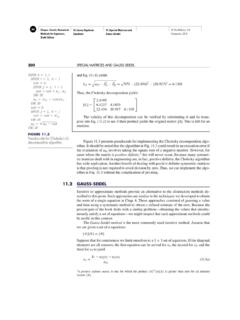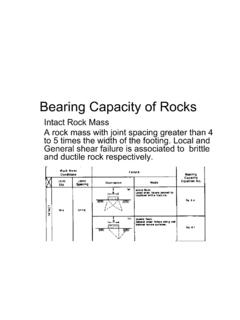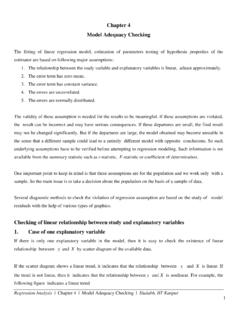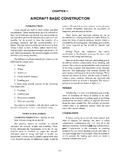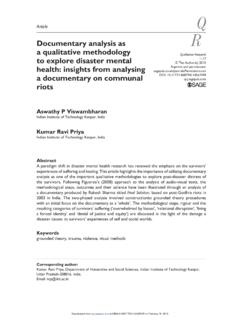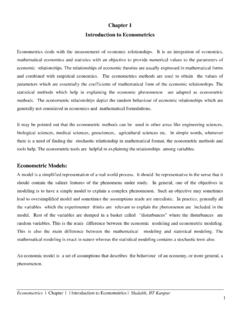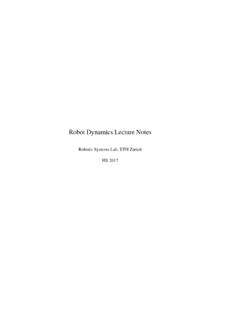Transcription of Analysis and Design Optimization of a Robotic Gripper ...
1 See discussions, stats, and author profiles for this publication at: Analysis and Design Optimization of a Robotic Gripper Using Multiobjective Genetic Algorithm ARTICLE in IEEE TRANSACTIONS ON SYSTEMS MAN AND CYBERNETICS FEBRUARY 2015. DOI: READS. 27. 3 AUTHORS, INCLUDING: Rituparna Datta Bishakh Bhattacharya Korea Advanced Institute of Science and Tec Indian Institute of Technology Kanpur 24 PUBLICATIONS 99 CITATIONS 64 PUBLICATIONS 157 CITATIONS. SEE PROFILE SEE PROFILE. Available from: Bishakh Bhattacharya Retrieved on: 28 September 2015. This article has been accepted for inclusion in a future issue of this journal. Content is final as presented, with the exception of pagination. IEEE TRANSACTIONS ON SYSTEMS, MAN, AND CYBERNETICS: SYSTEMS 1. Analysis and Design Optimization of a Robotic Gripper Using Multiobjective Genetic Algorithm Rituparna Datta, Shikhar Pradhan, and Bishakh Bhattacharya Abstract robot Gripper Design is an active research area due on the application of a universal hand Gripper for the grip- to its wide spread applicability in automation, especially for ping of a variety of objects and materials in the industrial high-precision micro-machining.
2 This paper deals with a multiob- environments. Such a device is desirable in order to avoid the jective Optimization problem which is nonlinear, multimodal, and originally formulated. The previous work, however, had treated multiplicity of gripping tools normally required, and takes one the actuator as a blackbox. The system model has been modi- closer to the versatility of the human hand. fied by integrating an actuator model into the Robotic Gripper A robot Gripper control system is developed by [4] using problem. A generic actuation system (for example, a voice coil polyvinylidene fluoride (PVDF)-based piezoelectric sensors, actuator) which generates force proportional to the applied volt- which can damp exerted force actively and reduce the rise age is considered. The actuating system is modeled as a stack consisting of the individual actuator elements arranged in series time related to the step input significantly.
3 Proportional and and parallel arrays in four different combinations. With the derivative control systems are used and the results obtained incorporation of voltage into the problem, which is related to are verified experimentally. Aggarwal et al. [5] have proposed both actuator force and manipulator displacement, the problem a method for the cooperation between a four-degrees of free- becomes more realistic and can be integrated with many real- dom Robotic hand and a human. To measure the force applied life Gripper simulations. Multiobjective evolutionary algorithm is used to solve the modified biobjective problem and to opti- by the human on the object during cooperation, the authors mally find the dimensions of links and the joint angle of a robot have developed a multilayer PVDF-based shear force sensor Gripper . A force voltage relationship can be obtained from each for Robotic fingertips.
4 Of the nondominated solutions which helps the user to deter- With the advent of the computing technology, optimiza- mine the voltage to be applied depending on the application. tion is increasingly being integrated into robotics research. An innovization study is further carried out to find suitable relationships between the decision variables and the objective Most science and engineering Design Optimization problems functions. have different conflicting objectives to be satisfied simulta- neously. The fundamental challenge in these problems is to Index Terms Actuator modelling, genetic algorithm, multiob- jective Optimization , robot Gripper Design . search for the right balance amongst all the conflicting objec- tives. The intelligent solution for a multiobjective Optimization problem is to devise a set of solutions which satisfies all the I.
5 I NTRODUCTION objectives simultaneously. The set of solutions is known as robot Gripper is the end effector of a Robotic mech- nondominated solutions or Pareto-optimal solutions in which A anism. In this sense, it is akin to a human hand which allows one to pick and place any given object. grippers are all are equally important and are not dominated by one another. used in areas which involve hazardous tasks such as space Two recent studies have solved the simplified form of robot exploration, high-temperature welding, handling radioactive Gripper Design problem by considering it as single objec- materials, defusing bombs, mines and exploring shipwrecks, tive constrained Optimization problem [6], [7]. Both studies to name a few. Moreover, robot grippers are also useful in have proposed constraint handling techniques to efficiently areas that involve tasks which are complex in nature such as handle the constraints and used evolutionary algorithms to the fabrication of micro-electronic structures, surgery, and so solve the problem.
6 Lanni and Ceccarelli [8] have performed forth. A substantial amount of research has been done on this a multiobjective Optimization in Gripper by considering four subject. An extensive survey on Robotic -grasping can be found, different objective functions, such as grasping index, encum- where Bicchi and Kumar [2] addressed problems arising from brance of grasping mechanism, acceleration, and velocity for the building, planning, designing, and controlling operations finger Gripper with respect to the imposed working area. The of Robotic grippers . Reddy and Suresh [3] performed a study study is performed on an 8R2P linkage in a two-finger grip- per mechanism. To explore the effect of dimensional variation Manuscript received November 28, 2014; accepted February 22, 2015. on the performance of the robot Gripper , [9] have optimized This paper was recommended by Associate Editor R.
7 Roberts. the geometrical parameters. The problem is designed and The authors are with the Department of Mechanical Engineering, simulated using COMSOL. Dao and Huang [10] have used Indian Institute of Technology Kanpur, Kanpur 208016, India (e-mail: fuzzy logic-based Taguchi method to Design an optimized Digital Object Identifier robot Gripper . Ciocarlie et al. [11] have designed, optimized, 2168-2216 c 2015 IEEE. Personal use is permitted, but republication/redistribution requires IEEE permission. See for more information. This article has been accepted for inclusion in a future issue of this journal. Content is final as presented, with the exception of pagination. 2 IEEE TRANSACTIONS ON SYSTEMS, MAN, AND CYBERNETICS: SYSTEMS. and demonstrated the behavior of a tendon-driven Robotic grip- By using (1), we arrive at the following equation: per performing fingertip and enveloping grasps.)
8 The route k B L V N. of the active tendon and the parameters of the springs pro- P= . (2). R. viding passive extension forces are optimized in the work. Reference [12] has considered the robot Gripper Design prob- If the length of the coil, the magnetic field strength, the num- lem as a multiobjective Optimization problem. The study ber of coils, and the resistance of the coil are kept constant, (2). dealt with three gripping mechanisms of heavy-forging robot can be expressed as follows: grippers and used multiobjective genetic algorithm (GA) to P = Ac V (3). optimize the link lengths and the joint angle. A weighted sum approach is used to combine multiple objectives into a where single one. k B L N. Ac = . This paper deals with a problem initially introduced R. by Osyczka [1]. In that work, the Gripper Design problem is Zohar et al. [17] included actuator dynamics in their analy- formulated as a multiobjective Optimization problem.
9 GA is sis of a mobile robot , for the motion of which they proposed used to solve the nonlinear multiobjective Optimization prob- certain control strategies to ensure exponential convergence to lem. Some extensions of the formulation by Osyczka [1] can a desired trajectory. The robot model included kinematic and be found in [13] and [14]. Datta and Deb [14] have also dynamic equations as well as actuator dynamics. Howard [18]. used multiobjective GA to solve the above mentioned problem. inferred spring deflection by monitoring the displacement Deb and Srinivasan [15] have also conducted an innovization between actuator output and motor position, and used it to study to find some meaningful relationship that exists between measure the springs in series. For further study in actuators, the Optimization variables and the objective functions.
10 The readers are encouraged to look into [19] and [20]. However, a major limitation of the foregoing formulation [1] The rest of this paper is organized as follows. In is the absence of an actuator Analysis , which leads to the Section II, we provide the details of multiobjective formula- treatment of the actuator as a blackbox. A constant actua- tion of Gripper configuration Design . Thereafter, we present tor force, P, is assumed, and the manipulator displacement, z, conventional actuator formulation integrated with Gripper varies independently of P. In order to expand this problem, this mechanism. In Section IV, systems approach is presented. paper considers the generic model of a conventional actuator. Sections V and VI contain voltage manipulator displacement The assumed actuator delivers a force proportional to the volt- relationships and force manipulator displacement relation- age applied across it and the actuator-stiffness.

